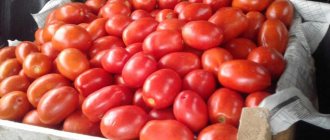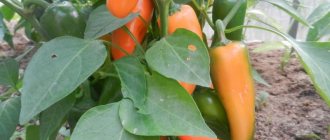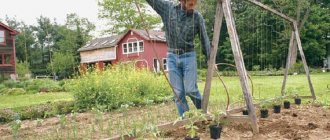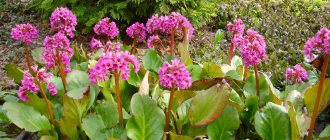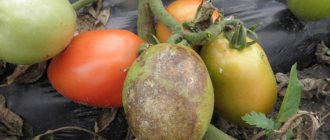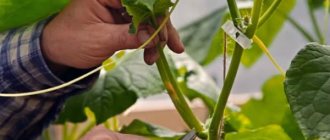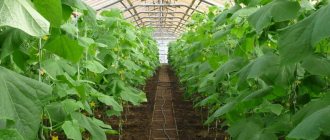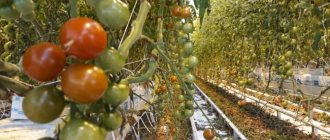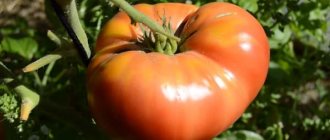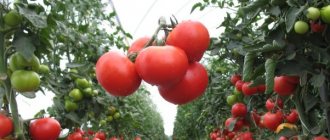The formation of tomato bushes in a greenhouse and open ground is carried out using pinching and pruning. Pinching is an agrotechnical technique when excess shoots are removed from the internodes (leaf axils) by cutting with pruning shears (scissors) or simply breaking them with your hands. Additionally, pinch the buds with your nails, preventing new shoots from appearing from them. Pruning includes the removal of the top and part of the leaves of the main and additional trunks in a similar way.
What is pinching tomatoes and why should it be done?
In their natural habitat, tomatoes are perennial crops, in which, during development, the bush begins to branch quite actively. This vegetable crop grows freely only in Mexico with its endless and warm summers. Tomatoes spend the first 3-4 months developing roots, gaining green mass, and only after that they begin to form buds.
In the hot Mexican climate, tomatoes have an endless warm period. They have nowhere to rush. Over time, inflorescences form on each shoot, so tomatoes do not require pinching under natural growing conditions.
With such a short gardening season as in Russia, loyalty to the vegetable will lead to the events described above - you will get a decorative, but very beautiful flowering bush.
As the plant grows, side shoots appear from the axils of its leaves, which are considered stupid. In addition to their complete stupidity, they also take away nutrients from the fruits themselves, preventing them from growing and developing.
The appearance of these branches causes the bush to actively grow. For every useful branch, where the fruit will later be formed, as a rule, there are more than 6 useless ones.
These lateral branches are called “stepson”. As the bush develops, it is customary to remove them. This process is called stepsoning.
Pinching is a special agrotechnical procedure in vegetable growing aimed at increasing productivity. Pinching is necessary for optimal development of the bush through its correct formation.
Thus, after removing excess branches, only fruit-bearing ones remain on the bush, which allows for more efficient and targeted use of applied fertilizers and nutrients from the soil.
Particularly many unnecessary side shoots are formed on tall varieties, in which a branch with tomatoes is formed only in the area of 7-11 leaves.
Possible mistakes
Sometimes novice gardeners are too lazy to plant their bushes regularly. Then you have to remove a large number of shoots at one time. As a result of this procedure, the plant spends a lot of energy on recovery. In addition, with this approach, most of the nutrients are spent on the growth of green mass, and not on the formation of ovaries.
Another mistake is removing fruiting shoots instead of stepsons. A fruiting branch is a shoot coming from a stem with formed inflorescences.
Do not use dirty tools to remove shoots. Before and after work, pruners, knives or other tools are disinfected with a solution of chlorhexidine, alcohol, potassium permanganate or bleach.
Advice! In order not to waste time on disinfecting the instrument, you can tear off the stepsons with your hands.
Unlike other events, stepsoning is best done during the day in sunny weather. In dampness and lack of sun, wounds on the plant heal slowly. This increases the likelihood of contracting viral or infectious diseases.
The benefits of pinching
- Fruit ripening occurs 2 weeks earlier;
- you get more ripe tomatoes by the end of the season;
- tomatoes grow to large sizes;
- the likelihood of contracting infections is reduced, as the bush itself becomes less dense;
- tomatoes get more sunlight;
- sugars accumulate in the pulp in greater quantities.
To achieve the desired result, the bush formation procedure must be carried out competently and systematically.
Let's look at the operation in more detail. Below are step-by-step instructions, formation schemes, features of working with different varieties, approaches to the procedure in a greenhouse and on open ground.
When to plant tomatoes
The main rule of a fighter with stepchildren is the correct choice of time and procedure.
The very first pinching is carried out 14 days after planting the seedlings in the ground, as soon as the flowers in the lower cluster open. After the first stepsoning, this operation will need to be repeated regularly - every 10-14 days.
This period was not chosen by chance. It will allow you not to miss all the newly growing shoots, and will prevent the bush from thickening.
It is important to remember that in reality, the timing of stepsoning may be blurred. Some vegetable growers carry out this operation already when they are gartering tomatoes.
For pinching, choose a warm, clear day, and do the procedure in the morning, so that by the evening the wounds from pruning or breaking off have time to heal.
The most optimal time is from 9 to 11 o'clock.
Dates
They begin pinching by waiting until the first shoot is formed above the lowest inflorescence. It is important not to let it grow more than 3-5 cm in length, as nutrients are wasted on its growth.
Further, similar work should be done weekly, choosing the morning hours. The wound should heal by the evening. The procedure begins with healthy tomatoes; suspicious and diseased bushes should be treated last, so as not to spread diseases to other plants.
How to distinguish a stepson from a fruit cluster
The shoot, which is called the stepson, may develop a stem, but not a fruit-bearing branch. In order not to confuse a fruitful branch with a “dummy”, which are so similar at the beginning, let the shoots grow to 4-5 cm. This length, as a rule, is enough to see the difference.
First sign
On the shoot of the “stepchild” the buds of leaves are visible, and on the future fruitful branch – the rudiments of buds. There are no leaves on such a branch.
Second sign
Branches with fruits grow directly from the stem at a short distance from the rest of the shoots. Lateral stems are formed directly in the axils of the leaves - at the junction of the petiole and stem.
If you suspect an abnormal development of the plant, which is also possible, then leave the sprout for a day. Since the shoots grow quite quickly, in just a few hours there will be clear differences from the fruit-bearing branch.
Depending on the variety, tomatoes branch and form differently. Bushes of indeterminate (tall) varieties are most susceptible to growth. Without pinching, they can turn into a real tree, from which you most likely will not get fruit.
Such tomatoes need not only to be pinched, but also pinched, that is, the growth of the central stem must be limited.
By solving the problem of how to properly plant tomatoes in a greenhouse or garden, you can ensure the correct formation of this vegetable crop. Moreover, the option of forming the bushes themselves depends on the chosen scheme for carrying out this procedure. There are several of them.
Formation of determinate tomatoes
This variety grows up to one meter. After six tassels appear, growth stops. Brushes are located every two leaves. The first inflorescence is located above the eighth or ninth leaf.
You can form a variety using different methods:
- If tomatoes are grown in open soil, with one stem, then the stepsons must be removed. The fruits on them do not have time to ripen during the summer period. The brushes are not removed, the top is not cut off.
- If you grow a tomato in greenhouse conditions, with three stems, then leave two stepsons (the very last ones) and one stem (the main one). One tassel and one leaf are left on the stepsons. The formation of a tomato helps the plant acquire eight inflorescences. Development and maturation will occur if the soil is protected from cold temperatures.
- For tomatoes grown in greenhouses, the method of transferring the growth point to the shoot is suitable. One main stem and the very last stepson are left from the bush. The escape will give tassels and new stepsons. Of these, you need to leave one more. Afterwards they leave another stepson, which moves away from the second shoot. As a result, you will get three more tassels. From one plant you can get not six inflorescences, but ten. The tops are cut off, leaving only one leaf.
We recommend that you read the article: Features of growing tomatoes in a greenhouse.
Formation of superdeterminate tomatoes
This is an early variety that has the lowest bush height. Their harvest is small. There are three inflorescences per stem. There is no need to plant these varieties. The plant has few shoots.
The formation of superdeterminate tomatoes is carried out in two ways:
- Formation of tomatoes into three stems in greenhouse conditions. For one bush, leave the main stem and two shoots from it. As a result, three tassels with fruits grow.
- Forming tomatoes into two stems in a greenhouse. This method is best for super-determinate tomatoes. Formation can also be done for plants in open soil. Leave the main stem and one shoot from it. The harvest will be small, but all the fruits will be large.
You may be interested in the article: Tomato blossom end rot: how to fight.
If the tomato variety is unknown, then it is better to form it into one stem. These tomatoes will have six inflorescences. There won't be much harvest, but there will definitely be one. This is the best option for this plant.
Three pinning schemes
As mentioned above, the option for forming bushes depends on the chosen scheme for the pinching procedure. The question of how to form tomato bushes can be solved in three ways, depending on how many branches are left.
The following types of procedure are distinguished.
1 stem pattern
With this scheme, all side shoots are removed, leaving only the stem for future fruits. The main advantage with this option is the speed of ripening and the large size of the vegetables.
The downside is that the bush grows to a great height and requires obligatory garter. Otherwise, it is almost guaranteed to break under the weight of ripening tomatoes.
2 stem pattern
This scheme does not involve the removal of all stepchildren. In addition to the main stem, you must leave 1 side shoot. As a rule, the strongest shoot located directly under the first inflorescence is chosen.
We cut off the rest.
3 stem pattern
The principle is already clear. In addition to the main stem, we leave 2 side shoots.
Stepchildren that cannot be removed are selected as follows: we find the strongest branch next to the lower inflorescence, after which, in the immediate vicinity, we find another strong branch.
We cut off the rest.
Choosing the right scheme for a greenhouse and an open bed
Growing tomatoes in a greenhouse, as a rule, is carried out according to the 1st and 2nd schemes, since a 3-flowered bush is rarely formed in them. On open ground, the procedure can be carried out using any option, depending on the variety of tomatoes.
If we consider the pinching technology itself for a greenhouse and an open bed, then they have no differences. The first operation is carried out when buds appear, until the side shoots have grown more than 5 centimeters. With a larger size of the removed shoot, the likelihood of disease in the tomato bush increases. Then we carry out the procedure every 10-14 days.
Formation of indeterminate tomatoes
Indeterminate tomatoes have unlimited growth. The first fruit cluster is laid above the 10-12th leaf, the bush grows for a long time to the required height, the inflorescences are located rarely (every 3 leaves). Typically, indeterminates include the latest varieties, which are famous for their large yields. In the middle zone, such tomatoes are grown only in protected soil.
Indeterminate tomatoes always form a single stem . There is no point in leaving side shoots on the bush: by the time flowers appear on them, summer will already be over, while the plant will spend energy on setting tomatoes, and they will not have enough moisture, heat and nutrients, so the fruits will not have time to ripen.
When forming a bush, you need to decide on the number of fruit clusters.
1. Tomatoes grown in a greenhouse are left with 7 clusters (inflorescences). In this case, one leaf is left above the upper inflorescence, and the tip above it is cut off. Such a bush stops growing and directs all its energy to ripening juicy fruits.
2. When growing in open ground (this is possible in southern regions with a mild climate), 5 bunches are left on the tomato bush, since the rest will not have time to form ripe fruits. One leaf is also left above the upper inflorescence and the top is cut off.
Scheme of formation of tomatoes of indeterminate varieties
